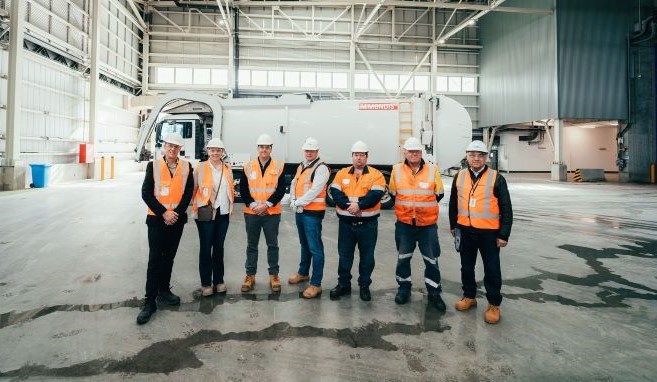Search
Locations REMONDIS Australia
The whole picture - with just a single click. Find out here where our branches are located, what services they offer and how to contact them.
Locations REMONDIS Group
Discover the world of REMONDIS with its + branches and associated companies in more than countries across Europe, Africa, Asia and Australia.
- english
- english
- nederlands
- français
- español
- italiano
Landfill waste disposal takes up space, generates odour, methane and leachate
Energy from Waste (EfW) facilities turn non-recyclable waste into clean energy
REMONDIS takes a precinct-based approach when developing waste infrastructure
OPINION
CTO Alex Hatherly recently participated in an interview with Waste Management Review, facing questions about waste management in Australia and drawing comparisons with overseas practice. Below, Alex Hatherly reflects on the state of play.
_
It’s pleasing that so much interest has been generated off the back of this, reinforcing REMONDIS’ view that it’s time for Australia to have longer and deeper conversations about new approaches to what we do with waste, and how, when and where.
The current approach of recycling what’s easily accessible and shoving pretty much everything else into holes in the ground is from the dark ages.

Yes, we can manage the process to make it as ‘environmentally friendly’ as possible, but let’s not pretend it’s the best approach. In addition to taking up space and ripping up land, the practice generates odour, methane and leachate – hardly wonderful environmental outcomes.
So many in the waste management sector know this, but unfortunately the average person in the street and a lot of government decision makers don’t. Nor, unfortunately, is there widespread recognition of better ways of doing things.
The case for change
That’s why there’s an onus on industry leaders such as REMONDIS Australia to strengthen the case for change, and Energy from Waste technology has to be at the forefront of the conversation.
It’s understandable that some people in some local communities might not like the idea of Energy from Waste facilities in their backyards. What anyone with doubts probably doesn’t know is there are thousands of such facilities all around the world, in dense urban areas across Europe, America and Asia – London, Paris, Copenhagen, Vienna and Singapore to name a few. Two operate within a few hundred metres of REMONDIS’ head office in Germany.
They’re tried and tested. They operate under the strictest environmental standards. They rely on cutting edge technology. They’re safe.
Best of all, they divert more than 95% of the waste from landfill. The combustion process converts the waste into electricity and a re-usable ash for construction projects and roads, with only the residual 5% going to landfill.
An added bonus is that the heat generated is used to produce a far cleaner form of electricity, as opposed to coal generated power. REMONDIS knows this all too well, given that we’ve been delivering Energy from Waste technology overseas for 30 years.
That’s not to suggest that Energy from Waste facilities are stand-alone silver bullet solutions.

A precinct-based approach is best
What we want to see more of in Australia is ‘precinct-based’ waste management approaches. The $700 million precinct we’re proposing at Swanbank, near Ipswich in Queensland, is a good example. This is about creating a wholistic and strategic one-stop-shop arrangement where we’d look to reuse, recycle or process pretty much all waste that arrives.
We can take recycling (which should always be the main goal) to a new level. What’s left over would be processed in the proposed on-site $400 million Energy from Waste facility. This plant would produce enough heat to create a cleaner form of electricity that can be fed straight into the grid – enough to power 50,000 homes every day of the year.
And almost 500,000 tonnes of waste would be diverted from landfill every year.
It’s not a case of blindly choosing locations for such precincts. Swanbank is ideal because it has long-term waste supply, water supply (needed for the Energy from Waste process) and existing electricity infrastructure.
Our message to communities and decision makers in Australia is that the precinct models we espouse, including Energy from Waste technology, are waste management game-changers.
If we want to keep up with world’s best practice, taking a closer look at these solutions is the first step in what should become a long, rewarding journey.

Alex Hatherly, Chief Technical Officer (CTO)
A Mechanical Engineer by training, Alex has many years of experience across large scale international logistics and manufacturing operations in steel and mining industries, working both for BlueScope and BHP. Alex has an MBA from Sydney Business School and has led large operations in several states across Australia. He joined the waste management industry in 2016 and has a passion for resource recovery that has fuelled REMONDIS’ determination to lead the introduction of Energy from Waste technology to Australia.
Enjoyed this article? Read more
ACT, NSW, QLD, SA, VIC, WA, National, Aqua, Energy from Waste, ETS, IMS, Industrial Services, Innovation, Medical, Announcement, Article
Sustainability Report 2023
WA, National, Energy from Waste, Innovation, Processing, Article
Energy recovery milestone







